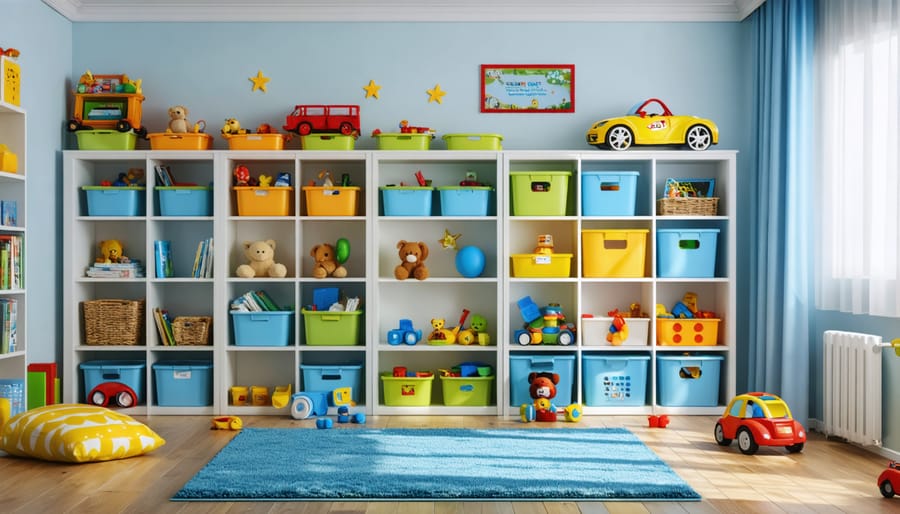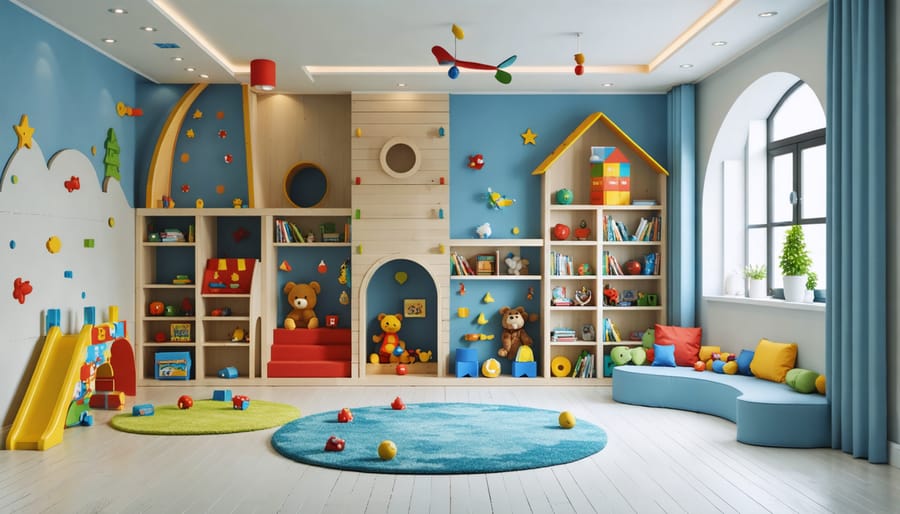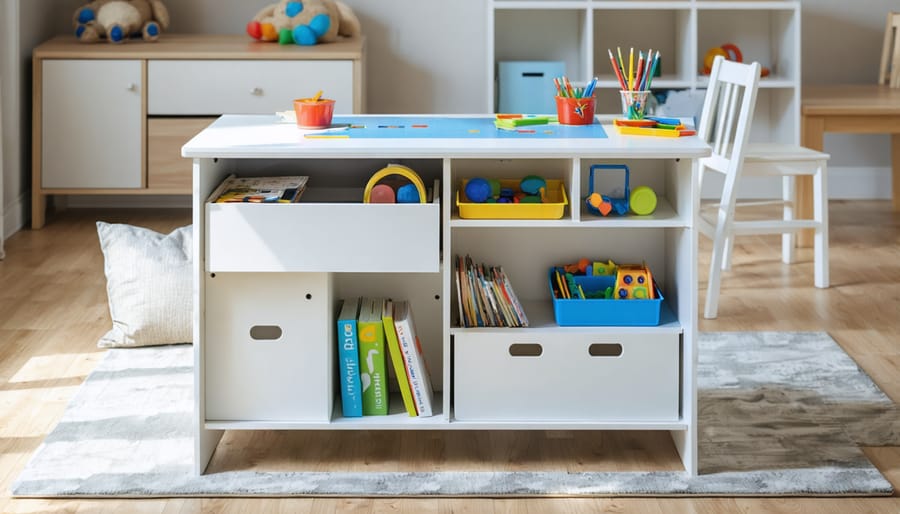Transform your cluttered playspace into a magical playroom design that sparks creativity and maintains order. Designate distinct activity zones—reading nooks, art stations, and building areas—using colorful floor mats and low shelving units to create natural boundaries. Install child-height storage solutions with clear bins and picture labels, empowering kids to independently organize their toys while developing crucial organizational skills. Mount pegboards and floating shelves at kid-friendly heights to maximize vertical space and display favorite toys as room decor, simultaneously reducing floor clutter and creating an engaging visual environment.
Strategic toy rotation systems keep the space fresh and manageable, while soft lighting options and cozy seating areas create intimate spaces perfect for quiet play. Incorporate washable wall paint and stain-resistant carpeting to ensure your design remains beautiful through years of creative play. Safety-conscious parents will appreciate rounded furniture corners and secured storage units, while style-minded decorators can embrace coordinated color schemes that grow with their children.
Smart Storage Solutions That Grow with Your Child
Accessible Storage Systems
Creating a playroom that promotes independence starts with implementing smart storage solutions that children can easily access and manage themselves. Low-level open shelving units are perfect for toddlers and younger children, allowing them to see and reach their toys without assistance. Consider using clear plastic bins or fabric containers with picture labels, making it simple for kids to identify where items belong.
For older children, incorporate a mix of closed and open storage options. Wall-mounted cubbies at their height encourage responsibility while keeping frequently used items within reach. Color-coding storage bins by toy category or activity type can make cleanup time more engaging and help establish organizational habits early on.
Make use of vertical space with adjustable shelving systems that can grow with your child. Install hooks at kid-friendly heights for dress-up clothes and bags, and consider rolling storage carts that can be easily moved during playtime. Toy rotation systems using labeled bins stored higher up can help manage clutter while keeping the play space fresh and exciting.
Don’t forget to include designated spots for crafting supplies and educational materials. Use drawer organizers and small containers to keep art supplies sorted, and implement a cleanup station with easy-access cleaning tools sized for little hands. This thoughtful approach to storage not only keeps the space tidy but also teaches valuable organizational skills that last a lifetime.

Rotating Toy Display Methods
Keeping toys fresh and exciting for children doesn’t always mean buying new ones. Instead, try implementing a rotating toy system that helps maintain interest while preventing toy overwhelm. Start by dividing toys into themed categories like building blocks, creative play, educational items, and pretend play sets.
Store about two-thirds of the toys in clearly labeled bins or boxes in a closet or basement, leaving out only a selection that your child can reasonably manage. Every two to three weeks, swap out some of the available toys with stored ones. This method not only makes cleanup easier but also creates excitement when “new” toys emerge from storage.
Consider creating themed rotations that align with current interests or learning objectives. For example, feature dinosaur toys alongside dinosaur books and puzzles one week, then switch to a transportation theme the next. Use clear storage containers so children can see what’s available without opening everything.
To make the rotation system more effective, observe which toys consistently engage your child and which ones are often ignored. Keep favorite comfort toys accessible at all times, but rotate supplementary pieces to maintain novelty. This approach not only keeps the play space organized but also helps children develop better focus and appreciation for their toys.
Remember to involve your children in the rotation process when age-appropriate. This teaches them organizational skills and gives them agency in their play environment.
Safety-First Design Elements
Childproofing Essentials
Creating a safe play environment is crucial when designing a toy room, and implementing proper child-safe home design measures ensures peace of mind for parents. Let’s break down essential childproofing elements by age group to create a secure play space.
For infants and toddlers (0-3 years):
• Install outlet covers on all electrical sockets
• Use furniture anchors to secure bookcases and storage units
• Choose rounded furniture corners or add corner protectors
• Ensure window treatments have no loose cords
• Install safety gates at doorways if needed
• Select non-toxic, washable paint for walls
For preschoolers (3-5 years):
• Use child-safe locks on storage containers
• Keep small items stored in high cabinets
• Install window guards to prevent falls
• Use non-slip mats under area rugs
• Choose storage solutions with soft-close features
• Maintain clear pathways for active play
For school-age children (5+ years):
• Create designated spaces for art supplies and materials
• Install adequate lighting for reading and activities
• Use storage solutions that children can safely access
• Keep emergency contacts visible but out of reach
• Ensure proper ventilation for craft areas
• Label storage areas for easy organization
Universal safety measures:
• Regular safety checks of toys and equipment
• Proper mounting of TVs and electronics
• Installation of smoke detectors
• Use of child-safe cleaning products
• Maintaining clear emergency exits
• Regular updates to first-aid supplies
Remember to periodically reassess safety measures as children grow and their play patterns change. Keep cleaning supplies and potentially harmful items completely out of the toy room, and establish clear rules about toy room safety with your children.

Safe Flooring Options
When it comes to creating a safe play environment, flooring choice plays a crucial role in preventing injuries and providing comfort during active play. The best flooring options combine durability with shock-absorption properties to keep your little ones protected during their adventures.
Foam puzzle mats are a popular choice among parents, offering excellent cushioning and easy maintenance. These interlocking tiles come in various colors and patterns, adding a playful element while providing a soft landing surface. They’re also simple to replace piece by piece if damage occurs, making them cost-effective in the long run.
Cork flooring presents another excellent option, offering natural cushioning and antimicrobial properties. It’s warm underfoot, naturally resistant to mold and mildew, and provides good sound insulation – perfect for containing the noise of excited play. Cork is also environmentally friendly and sustainable, making it an eco-conscious choice.
Low-pile carpet with thick padding underneath offers a classic solution that combines comfort with stability. Look for stain-resistant varieties with tight loops rather than long fibers, which can trap toys and make cleaning more challenging. Consider carpet tiles as an alternative, allowing you to replace sections as needed without redoing the entire floor.
Rubber flooring, similar to what you might see in commercial playgrounds, provides superior impact absorption and durability. Available in sheets or tiles, rubber flooring comes in various thicknesses and colors, allowing you to create fun patterns while maintaining safety standards.
For those preferring hard surfaces, luxury vinyl planks (LVP) offer a practical compromise. While not as soft as foam or rubber options, quality LVP provides better impact absorption than traditional hardwood or tile, and it’s highly resistant to water damage and scratches. Layer it with strategic placement of area rugs or play mats in high-activity zones for added protection.
Remember to install proper underlayment beneath your chosen flooring to enhance cushioning and shock absorption. This extra layer can significantly improve the safety performance of any flooring type while adding comfort and noise reduction benefits.

Creative Play Zones
Active Play Space
An active play space is essential for children’s physical development and energy release. Designate a specific area where kids can move freely, jump, dance, and engage in gross motor activities without worrying about bumping into furniture or walls.
Start by clearing a generous floor space and installing soft flooring options like foam puzzle mats or plush carpeting to cushion falls and reduce noise. Consider adding a climbing wall with lower heights and safety mats underneath, or a balance beam set close to the ground for developing coordination skills.
Hanging swings or suspended activity bars from reinforced ceiling points can create an indoor movement zone that’s perfect for rainy days. Just ensure proper installation and weight limits are strictly followed. A dedicated tumbling area with gymnastics mats encourages creative movement while keeping safety in mind.
Storage solutions for active play equipment should be easily accessible yet secure. Use wall-mounted hooks for jump ropes and hula hoops, and rolling bins for balls and sports equipment. Consider installing a basketball hoop at an age-appropriate height or creating a target wall for throwing games.
Remember to maintain clear pathways between activity zones and keep ceiling heights in mind when planning vertical play elements. Use bright, energizing colors in this area to stimulate movement and excitement, but avoid overwhelming patterns that might create visual confusion during active play.
For smaller spaces, consider modular equipment that can be easily stored when not in use, allowing the area to serve multiple purposes throughout the day. Always supervise active play and regularly check equipment for wear and tear to ensure ongoing safety.
Quiet Corner Design
Every toy room needs a designated quiet corner where children can retreat for calmer activities like reading, drawing, or simply unwinding. The key to creating peaceful quiet spaces is to clearly separate them from more active play areas using visual and physical boundaries.
Start by selecting a corner away from high-traffic areas, ideally near a window for natural light. Add soft elements like plush floor cushions, a cozy reading chair, or a bean bag to make the space inviting. A small area rug can help define the space while providing comfortable seating on the floor. Consider installing floating shelves at child-height to display books with their covers facing forward, making them more appealing and accessible.
Lighting plays a crucial role in setting the right mood. Layer your lighting options with a combination of natural light, soft overhead lighting, and a small table lamp for focused activities. String lights can add a magical touch without being overstimulating.
To minimize distractions, use room dividers, curtains, or even strategically placed bookcases to create a sense of enclosure. Keep the color palette calm and soothing – think soft blues, gentle greens, or warm neutrals. Add texture through soft blankets and pillows, but avoid too many patterns that might compete for attention.
Consider incorporating nature elements like small plants or nature-themed artwork to enhance the peaceful atmosphere. A small table or lap desk provides a stable surface for drawing or writing, while wall-mounted organizers keep art supplies within reach but neatly contained.
Flexible Furniture Choices
Multi-Purpose Pieces
Investing in multi-purpose furniture is a game-changer for toy rooms, offering flexibility as your children grow and maximizing every square foot of space. Consider ottomans with hidden storage compartments – perfect for quick cleanup and extra seating during playdates. A convertible art table that adjusts in height can transition from toddler crafts to homework sessions for older kids, making it a long-term investment.
Look for modular furniture pieces that can be reconfigured as needs change. Cube storage units work wonderfully as toy organizers in the early years and can later become bookshelf displays or gaming stations. Bean bags with washable covers serve as cozy reading nooks and casual seating for video gaming sessions, adapting effortlessly to changing interests.
Wall-mounted desks that fold down when needed save valuable floor space and can double as art displays or homework stations. Consider investing in storage benches that line the walls – they provide seating, storage, and can even become a stage for imaginative play. Rolling carts make excellent art supply stations that can be tucked away when not in use.
Remember to choose sturdy, well-made pieces that can withstand years of use. Opt for neutral colors and classic designs that won’t feel childish as your kids grow older. This approach ensures your toy room furniture evolves alongside your children, providing both functionality and longevity.

Safety-Conscious Selection
When designing your toy room, safety should always be your top priority. Start by selecting furniture with rounded corners and smooth edges to prevent injuries from accidental bumps. Look for pieces that meet current safety standards and have anti-tip features, especially for taller items like bookcases and storage units.
Choose low-profile furniture that’s sturdy and won’t easily topple over. Opt for pieces made from non-toxic materials and finishes, particularly important for younger children who might mouth surfaces. Secure all furniture to the walls using appropriate anchoring systems, even if items seem stable on their own.
Storage solutions should be easily accessible to children while remaining safe. Consider cube organizers with soft fabric bins instead of heavy wooden toy boxes that could pinch fingers. Avoid furniture with glass elements or sharp hardware that could pose risks during active play.
For seating, select child-sized options with stable bases. Beanbags and floor cushions make excellent choices as they’re both comfortable and fall-safe. If including tables, ensure they’re at an appropriate height for your children and feature rounded corners with protective bumpers.
Remember to regularly inspect furniture for loose parts, splinters, or wear that might create hazards. By prioritizing safety in your furniture choices, you’ll create a space where children can play freely while giving you peace of mind.
Stimulating Decor Ideas
Transform your toy room into a learning wonderland with decor that sparks imagination and development. Start with stimulating color choices that create distinct activity zones – calming blues for reading corners, energizing yellows for creative spaces, and balanced greens for building areas.
Install educational wall decals featuring alphabets, numbers, or world maps to make learning a natural part of playtime. Consider mounting a large magnetic board or chalkboard wall where children can practice writing, drawing, and displaying their artwork. This not only encourages creativity but also gives them a sense of pride in their space.
Create an imaginative ceiling display with hanging mobiles featuring solar systems, geometric shapes, or nature themes. These eye-catching elements add visual interest while introducing educational concepts. Add string lights or star projectors to create a magical atmosphere during storytelling sessions.
Incorporate texture-rich elements like sensory walls with different materials, interactive busy boards, or weather stations. These hands-on features promote fine motor skills and cognitive development while adding decorative appeal to the room.
Display books with their covers facing forward on wall-mounted shelves, creating both a functional library and an engaging wall feature. Rotate the displayed books regularly to maintain interest and create fresh learning opportunities.
Consider adding growth charts, educational posters, and framed artwork at child-height levels. This personal touch makes the space more engaging while reinforcing learning concepts through visual cues. Remember to leave some wall space empty for rotating displays of your child’s creative work, helping them feel ownership of their special space.
Creating the perfect toy room isn’t just about organizing toys – it’s about crafting a space that sparks imagination, encourages learning, and makes cleanup time easier for everyone. By implementing the design strategies we’ve discussed, you can transform any room into an inviting play area that both children and parents will love.
Remember to start with a solid organizational system that works for your family’s needs. Choose storage solutions that are easily accessible to children, incorporate zones for different activities, and select safe, durable materials that can withstand active play. Don’t forget to include elements that can grow with your child, ensuring the space remains functional for years to come.
Most importantly, let your creativity shine while keeping safety in mind. Whether you opt for a reading nook, an art station, or a combination of play areas, the key is to create a space that reflects your child’s interests while maintaining order and functionality. With these guidelines in hand, you’re ready to design a toy room that’s not just organized and safe, but truly magical for your little ones.
Start small, implement changes gradually, and enjoy watching your children thrive in their new play space!
